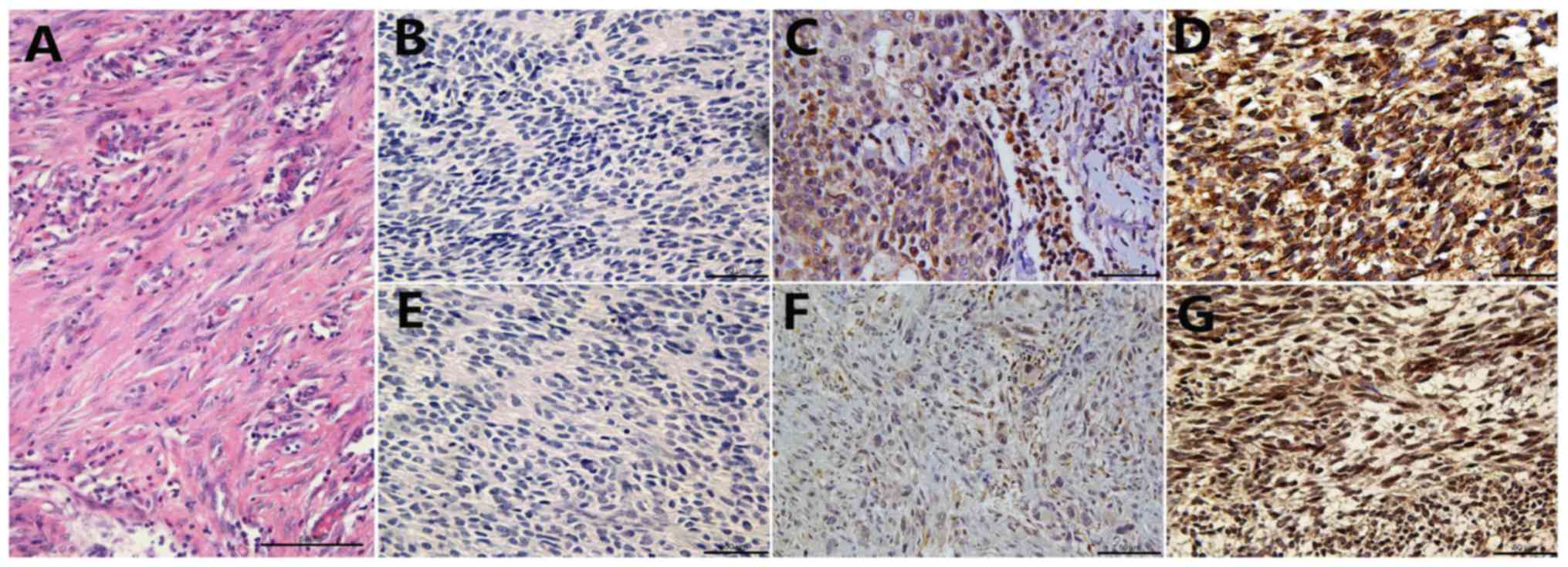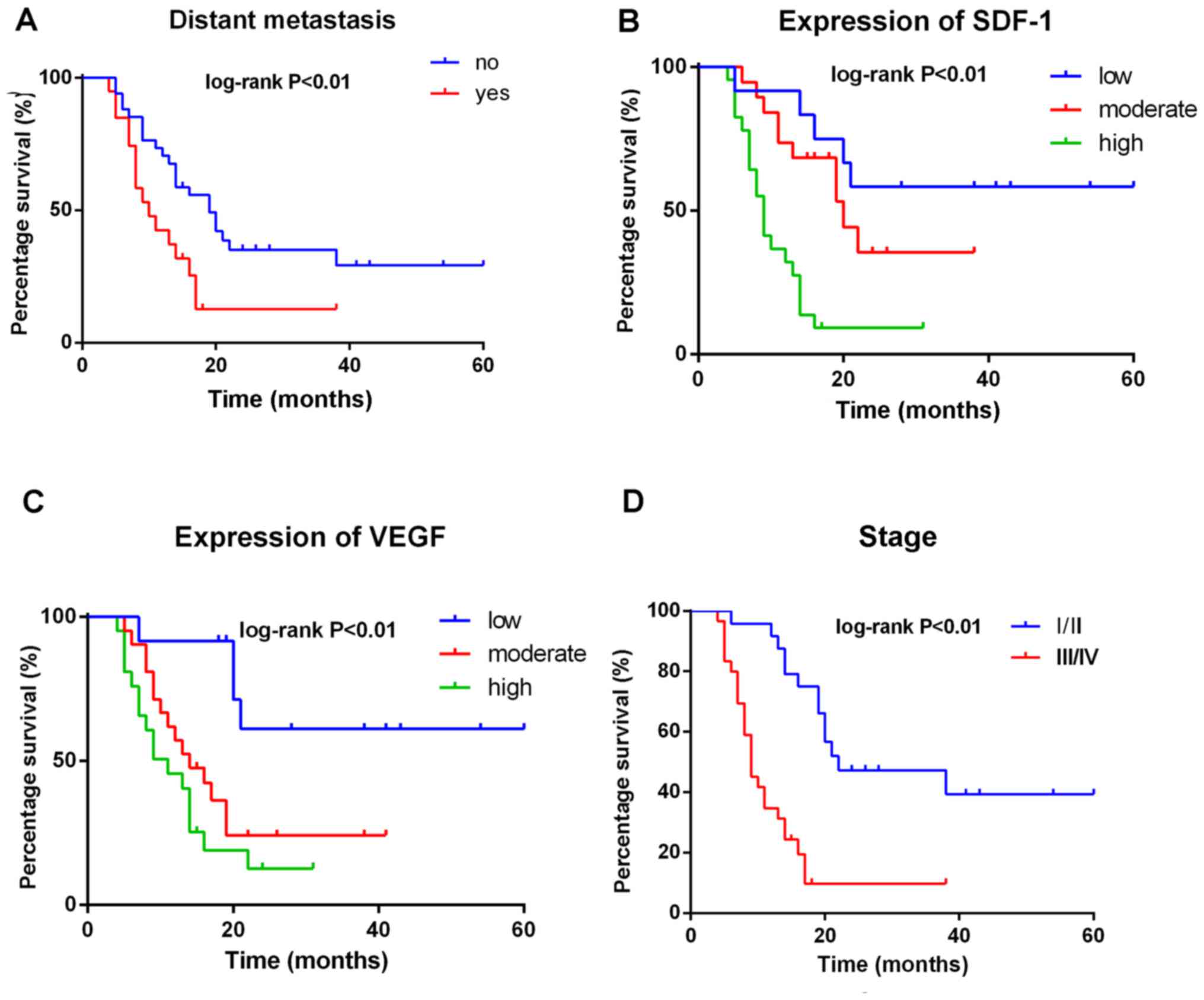|
1
|
Nielsen TO, Poulin NM and Ladanyi M:
Synovial sarcoma: Recent discoveries as a roadmap to new avenues
for therapy. Cancer Discov. 5:124–134. 2015. View Article : Google Scholar : PubMed/NCBI
|
|
2
|
Spillane AJ, A'Hern R, Judson IR, Fisher C
and Thomas JM: Synovial sarcoma: A clinicopathologic, staging, and
prognostic assessment. J Clin Oncol. 18:3794–3803. 2000. View Article : Google Scholar : PubMed/NCBI
|
|
3
|
Wunder JS, Nielsen TO, Maki RG, O'Sullivan
B and Alman BA: Opportunities for improving the therapeutic ratio
for patients with sarcoma. Lancet Oncol. 8:513–524. 2007.
View Article : Google Scholar : PubMed/NCBI
|
|
4
|
Thway K and Fisher C: Synovial sarcoma:
Defining features and diagnostic evolution. Ann Diagn Pathol.
18:369–380. 2014. View Article : Google Scholar : PubMed/NCBI
|
|
5
|
Palmerini E, Paioli A and Ferrari S:
Emerging therapeutic targets for synovial sarcoma. Expert Rev
Anticancer Ther. 14:791–806. 2014. View Article : Google Scholar : PubMed/NCBI
|
|
6
|
Murphy PM: Chemokines and the molecular
basis of cancer metastasis. N Engl J Med. 345:833–835. 2001.
View Article : Google Scholar : PubMed/NCBI
|
|
7
|
Kuil J, Buckle T and van Leeuwen FW:
Imaging agents for the chemokine receptor 4 (CXCR4). Chem Soc Rev.
41:5239–5261. 2012. View Article : Google Scholar : PubMed/NCBI
|
|
8
|
Ruiz de Almodovar C, Luttun A and
Carmeliet P: An SDF-1 trap for myeloid cells stimulates
angiogenesis. Cell. 124:18–21. 2006. View Article : Google Scholar : PubMed/NCBI
|
|
9
|
Kiel MJ and Morrison SJ: Maintaining
hematopoietic stem cells in the vascular niche. Immunity.
25:862–864. 2006. View Article : Google Scholar : PubMed/NCBI
|
|
10
|
Ratajczak MZ, Kim CH, Abdel-Latif A,
Schneider G, Kucia M, Morris AJ, Laughlin MJ and Ratajczak J: A
novel perspective on stem cell homing and mobilization: Review on
bioactive lipids as potent chemoattractants and cationic peptides
as underappreciated modulators of responsiveness to SDF-1
gradients. Leukemia. 26:63–72. 2012. View Article : Google Scholar : PubMed/NCBI
|
|
11
|
Klein RS and Rubin JB: Immune and nervous
system CXCL12 and CXCR4: Parallel roles in patterning and
plasticity. Trends Immunol. 25:306–314. 2004. View Article : Google Scholar : PubMed/NCBI
|
|
12
|
Epstein RJ: The CXCL12-CXCR4 chemotactic
pathway as a target of adjuvant breast cancer therapies. Nat Rev
Cancer. 4:901–909. 2004. View
Article : Google Scholar : PubMed/NCBI
|
|
13
|
Burger JA and Kipps TJ: CXCR4: A key
receptor in the crosstalk between tumor cells and their
microenvironment. Blood. 107:1761–1767. 2006. View Article : Google Scholar : PubMed/NCBI
|
|
14
|
Sun X, Cheng G, Hao M, Zheng J, Zhou X,
Zhang J, Taichman RS, Pienta KJ and Wang J: CXCL12/CXCR4/CXCR7
chemokine axis and cancer progression. Cancer Metastasis Rev.
29:709–722. 2010. View Article : Google Scholar : PubMed/NCBI
|
|
15
|
Yao C, Li P, Song H, Song F, Qu Y, Ma X,
Shi R and Wu J: CXCL12/CXCR4 axis upregulates twist to induce EMT
in human glioblastoma. Mol Neurobiol. 53:3948–3953. 2016.
View Article : Google Scholar : PubMed/NCBI
|
|
16
|
Yang P, Wang G, Huo H, Li Q, Zhao Y and
Liu Y: SDF-1/CXCR4 signaling up-regulates survivin to regulate
human sacral chondrosarcoma cell cycle and epithelial-mesenchymal
transition via ERK and PI3K/AKT pathway. Med Oncol. 32:3772015.
View Article : Google Scholar : PubMed/NCBI
|
|
17
|
Chen Y, Gou X, Kong DK, Wang X, Wang J,
Chen Z, Huang C and Zhou J: EMMPRIN regulates tumor growth and
metastasis by recruiting bone marrow-derived cells through
paracrine signaling of SDF-1 and VEGF. Oncotarget. 6:32575–32585.
2015.PubMed/NCBI
|
|
18
|
Hassan S, Buchanan M, Jahan K,
Aguilar-Mahecha A, Gaboury L, Muller WJ, Alsawafi Y, Mourskaia AA,
Siegel PM, Salvucci O and Basik M: CXCR4 peptide antagonist
inhibits primary breast tumor growth, metastasis and enhances the
efficacy of anti-VEGF treatment or docetaxel in a transgenic mouse
model. Int J Cancer. 129:225–232. 2011. View Article : Google Scholar : PubMed/NCBI
|
|
19
|
Eswarappa SM and Fox PL: Antiangiogenic
VEGF-Ax: A new participant in tumor angiogenesis. Cancer Res.
75:2765–2769. 2015. View Article : Google Scholar : PubMed/NCBI
|
|
20
|
Sápi Z: Pathology of soft tissue sarcomas.
Magy Onkol. 58:11–23. 2014.(In Hungarian). PubMed/NCBI
|
|
21
|
Kneisl JS, Coleman MM and Raut CP:
Outcomes in the management of adult soft tissue sarcomas. J Surg
Oncol. 110:527–538. 2014. View Article : Google Scholar : PubMed/NCBI
|
|
22
|
Sánchez-Martín L, Sánchez-Mateos P and
Cabañas C: CXCR7 impact on CXCL12 biology and disease. Trends Mol
Med. 19:12–22. 2013. View Article : Google Scholar : PubMed/NCBI
|
|
23
|
Woodard LE and Nimmagadda S: CXCR4-based
imaging agents. J Nucl Med. 52:1665–1669. 2011. View Article : Google Scholar : PubMed/NCBI
|
|
24
|
Barbieri F, Thellung S, Würth R, Gatto F,
Corsaro A, Villa V, Nizzari M, Albertelli M, Ferone D and Florio T:
Emerging targets in pituitary adenomas: Role of the CXCL12/CXCR4-R7
system. Int J Endocrinol. 2014:7535242014. View Article : Google Scholar : PubMed/NCBI
|
|
25
|
Chatterjee S, Behnam Azad B and Nimmagadda
S: The intricate role of CXCR4 in cancer. Adv Cancer Res.
124:31–82. 2014. View Article : Google Scholar : PubMed/NCBI
|
|
26
|
Mao AW, Jiang TH, Sun XJ and Peng J:
Application of chemokine receptor antagonist with stents reduces
local inflammation and suppresses cancer growth. Tumour Biol.
36:8637–8643. 2015. View Article : Google Scholar : PubMed/NCBI
|
|
27
|
Lee HJ and Jo DY: The role of the
CXCR4/CXCL12 axis and its clinical implications in gastric cancer.
Histol Histopathol. 27:1155–1161. 2012.PubMed/NCBI
|
|
28
|
García-Román J and Zentella-Dehesa A:
Vascular permeability changes involved in tumor metastasis. Cancer
Lett. 335:259–269. 2013. View Article : Google Scholar : PubMed/NCBI
|
|
29
|
Teicher BA and Fricker SP: CXCL12
(SDF-1)/CXCR4 pathway in cancer. Clin Cancer Res. 16:2927–2931.
2010. View Article : Google Scholar : PubMed/NCBI
|
|
30
|
Kampmann E, Altendorf-Hofmann A, Gibis S,
Lindner LH, Issels R, Kirchner T and Knösel T: VEGFR2 predicts
decreased patients survival in soft tissue sarcomas. Pathol Res
Pract. 211:726–730. 2015. View Article : Google Scholar : PubMed/NCBI
|
|
31
|
Ben-Baruch A: The multifaceted roles of
chemokines in malignancy. Cancer Metastasis Rev. 25:357–371. 2006.
View Article : Google Scholar : PubMed/NCBI
|
|
32
|
Kawauchi S, Fukuda T and Tsuneyoshi M:
Angiogenesis does not correlate with prognosis or expression of
vascular endothelial growth factor in synovial sarcomas. Oncol Rep.
6:959–964. 1999.PubMed/NCBI
|












